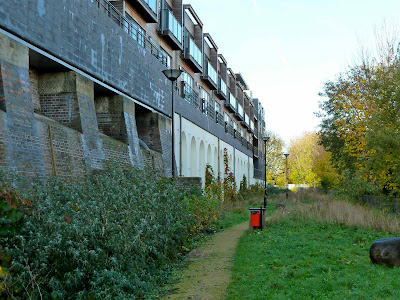In an article in the February issue of "What's Happening" magazine local business man Mike Holland proposes ways to solve Brighton's traffic problem. He seems to suggest that Brighton needs
more visitors than it gets at present, and would manage to get them if only it weren't for the traffic conditions and the difficulty and cost of parking. It is true that traffic is causing high pollution levels in the city, and that the cost of parking is punitive, but the suggestion that these factors are limiting vistor numbers hardly squares with the near continuous stream of traffic one sees every weekend queuing to get into Brighton. One wonders how they all manage to fit into Brighton's limited space, so where would all the extra cars that Mr Holland envisages go?
His answer would be to build a vast car park under Preston Park, citing as an example Regency Square. This is hardly an encouraging example. It was built against strong opposition and has only succeeded in nibbling at the parking problem; at the same time turning the Square into a sterile, unattractive space with insufficient top soil to support the vegetation such an open space requires. Such an operation in Preston Park doesn't bear thinking about. The excavation and building works would deny a large area of the park to a generation of youngsters, surely cause the loss of many mature trees, and leave an artificial, unattractive landscape.

To enable drivers to reach this parking paradise in the shortest possible time Mr Holland further proposes a flyover at Patcham roundabout to enable the A23 dual carriageway to continue through Patcham, Withdean and Preston all the way to his new car park. This would require a towering edifice to clear the already elevated A27: and the dual carriageway would inevitably take land from Patcham Place, Withdean Park, Surrenden Field, and diverse front gardens; involve the loss of many trees, and maybe, demolition of property.
The whole idea has strong echos of the 1960's Wilson Wormsley Plan, which proposed an elevated motorway from Preston Circus to the multi-storey car park in Church Street. This would have involved the demolition of 700 houses and devastated the Preston Circus and North Laine areas. Yet, with the benefit of hindsight, one can see that its contribution to alleviating modern traffic problems would have been negligible. To paraphrase Parkinson, "Traffic expands to occupy the space available to it".
Mr Holland obviously takes a great interest in Brighton and has done some good stuff. He sucessfully restored Stanmer House when its prospects looked dire, and saved the Engineerium. Brighton is lucky to have him but this is not one of his better ideas.
 The first Annual General Meeting of "Friends of the Pepperpot", is taking place on March 10th in the upstairs of the 'Pub with No Name' at 7.30 pm. As well as the constitutional stuff, there will be a presentation with a round up of the year’s activities, setting of goals for next year, a look ahead to future plans and an opportunity to view pictures and buy cards. Admission is free.
The first Annual General Meeting of "Friends of the Pepperpot", is taking place on March 10th in the upstairs of the 'Pub with No Name' at 7.30 pm. As well as the constitutional stuff, there will be a presentation with a round up of the year’s activities, setting of goals for next year, a look ahead to future plans and an opportunity to view pictures and buy cards. Admission is free. Later, on Saturday 19th March at the Brighton History Centre, a ‘Memory Day’ will be held. If you have memories you’d like to share you are invited to come along between 10.30 am and 3.30 pm. If you are coming please let Hamish MacGillivray know on: 07811-144622.
Later, on Saturday 19th March at the Brighton History Centre, a ‘Memory Day’ will be held. If you have memories you’d like to share you are invited to come along between 10.30 am and 3.30 pm. If you are coming please let Hamish MacGillivray know on: 07811-144622.


























